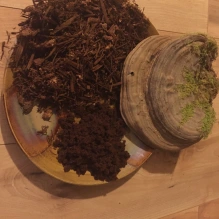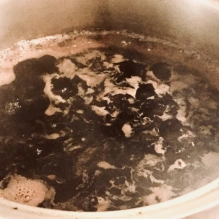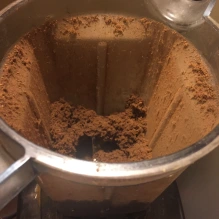This preparation makes it possible to get all the benefits of a mushroom dual extract, and doesn’t involve any alcohol. The initial boiling of the mushroom material breaks down the tough chitin cell wall and extracts the polysaccharides. The water is boiled down until there is a thick mushroom slurry. This slurry contains the polysaccharides, high molecular weight terpenes (still in the mushroom material itself), minerals, and sterols (still in the mushroom material). Since the water is extracting only limited amounts of the triterpene glycosides* and negligible amounts of other hydrophobic compounds, it is essential we consume the entirety of this slurry. Water can extract the polysaccharides and minerals, while the human body is an excellent solvent, and can take care of the rest. After dehydrating this slurry and following up with a grind, there is a powdery extract that is easy to add to oatmeal, coffee, soup, honey, tea, and anything else you desire mushroom extract in. This powdered extract can also be encapsulated.
*Triterpenes are common secondary metabolite compounds in medicinal mushrooms. Research shows that these compounds have cytotoxic effects on many cancer cell lines, they are anti-inflammatory, hepato-protective, anti-allergic, and anti-viral.(1,2,3,4,5,6,7,8)
Things to acquire:
A mushroom fruiting body; Turkey Tail, Artist Conk, Reishi, Red Belted Polypore, Willow Bracket, Lion’s Mane, etc.
Sharp knife for chopping
A pot to boil in
High speed blender
Dehydrator or oven
DIRECTIONS:
Chop freshly harvested mushroom fruiting body
Further grind fruiting body in blender
Dehydrate over night
Place in pot and cover with water
Boil down until there is a thick mushroom slurry
Place slurry on dehydrator tray (or oven tray)
Dehydrate 12-24 hrs at 110 degrees F (if using oven – use lowest setting possible)
Grind down in high speed blender
If you desire a less fibrous extract, sift further for a finer powder
Work Cited
Bhattarai G, Lee Y-H, Lee N-H, et al. Fomitoside-K from Fomitopsis nigra Induces Apoptosis of Human Oral Squamous Cell Carcinomas (YD-10B) via Mitochondrial Signaling Pathway. Biol Pharm Bull. 2012;35(10):1711-1719. doi:10.1248/bpb.12-00297.
Eo SK, Kim YS, Lee CK, Han SS. Antiviral activities of various water and methanol soluble substances isolated from Ganoderma lucidum. J Ethnopharmacol. 1999;68(1-3):129-136. doi:10.1016/S0378-8741(99)00067-7.
Guggenheim AG, Wright KM, Zwickey HL. Immune Modulation From Five Major Mushrooms: Application to Integrative Oncology. Integr Med. 2014;13(1):32-44.
Effects of triterpenes on the immune system. J Ethnopharmacol. 2010;128(1):1-14. doi:10.1016/j.jep.2009.12.045.
Ren G, Liu XY, Zhu HK, Yang SZ, Fu CX. Evaluation of cytotoxic activities of some medicinal polypore fungi from China. Fitoterapia. 2006;77(5):408-410. doi:10.1016/j.fitote.2006.05.004
Wang G, Zhao J, Liu J, Huang Y, Zhong J-J, Tang W. Enhancement of IL-2 and IFN-γ expression and NK cells activity involved in the anti-tumor effect of ganoderic acid Me in vivo. Int Immunopharmacol. 2007;7(6):864-870. doi:10.1016/j.intimp.2007.02.006
Yoshikawa K, Inoue M, Matsumoto Y, et al. Lanostane Triterpenoids and Triterpene Glycosides from the Fruit Body of Fomitopsis pinicola and Their Inhibitory Activity against COX-1 and COX-2. 2005:69-73.
Zhu Q, Bang TH, Ohnuki K, Sawai T, Sawai K, Shimizu K. Inhibition of neuraminidase by Ganoderma triterpenoids and implications for neuraminidase inhibitor design. Sci Rep. 2015;5(AUGUST):13194. doi:10.1038/srep13194.




Comments